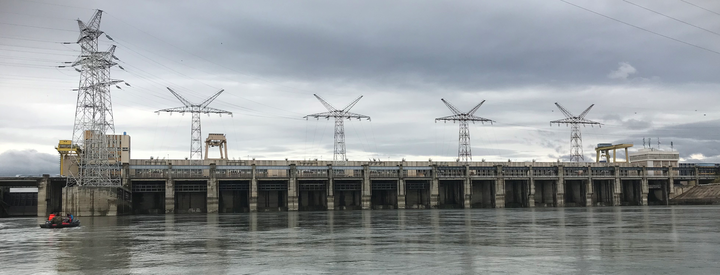WePass (RO & RS)
 Tracking fish downstream of IronGate2
Tracking fish downstream of IronGate2
Our group is leading the efforts to track fish in this large collaborative project. Main objective is to investigate the movement behaviour of several of the migratory species affected by the Iron Gate dams, e.g. some species of Danube Sturgeon. The fish behavioural data feed into the early planning phases and decissions on where it might be feasible to position fish passages for both up- and downstream migration. Hopefully, the fish passages, once established, will allow a significant proportion of the migratory fish species and individuals to successfully pass the Iron Gate dams.
This is truly as case where one size DOES NOT fit all. To achieve high-resolution 3D tracking of a large number of fish in this very challenging area, we use equipment and transmitters from Thelma Biotel (NO).

Project Partners
The overarching project is led by Marq Radeker, CDM Smith (DE), while the actual field work and fish tracking are done in close collaboration with great teams of colleagues from Romania and Serbia:
- Dr. Marian Paraschiv, Danube Delta National Institute For Research And Development (RO)
- Dr. Stefan Hont, Danube Delta National Institute For Research And Development (RO)
- Dr. Marian Iani, Danube Delta National Institute For Research And Development (RO)
- Dr. Gorčin Cvijanović, University of Belgrade (RS)
- Dr. Marija Smederavac Lalic, University of Belgrade (RS)
Project Background
See the offical WePass web-site at www.we-pass.org/.
Excerts from project Inception Report:
The Iron Gate I & II Dams remain the most significant river continuity interruption on the main stem of the Danube River, representing impenetrable obstacles for migratory fish species. The impact of the Iron Gate I & II Dams has resulted in sharp declines in the native Danube sturgeon populations in recent decades, causing substantial regional economic impact on the productivity of fisheries. Furthermore, of the original six native species, two are now extinct in the Dan-ube River Basin. For other migratory fish species, the dams result in loss of genetic diversity, non-accessibility of habitats and diminishing populations. In a European context the Iron Gate Dams are a top priority for river continuity restoration. Thus, restoration of fish passage at the Iron Gate Dams has been classified as being of “utmost priority” in the Danube River Basin Management Plan.
The setting at the Iron Gate is unprecedented and extremely challenging. The Iron Gate I & II Dams represent the largest fish migration barriers in Europe. There is no ready-to-use solution for fish passage restoration considering the scale of the river, the size of the target species (sturgeons up to 7 m long), the dimensions of the dam complexes and their morphological envi-ronments and location on the border of two countries, and the dual hydropower and navigation requirements. A “copy and paste approach” mirroring experiences of solutions in other large European rivers, such as the Rhine River, is not possible as the swimming behaviour of sturgeons is quite different from other migratory fishes. Therefore, the solutions demand innovative approaches and will have to be tailored to the unique situation at the Iron Gates. This will serve to ensure project success, which is critical as significant investments will be required for fish pass design, construction, and operation.
Over recent years, several projects have been carried out to develop knowledge about fish movements and the hydraulic functioning of the Iron Gate Dams. These projects have been ef-fective in establishing the ecological and technical knowledge base necessary to execute this comprehensive and challenging pilot project in a successful manner. Previous studies have also concluded that fish migration restoration is technically feasible at the Iron Gate I & II Dams. However, the most effective and economic solutions and locations are yet to be identified.